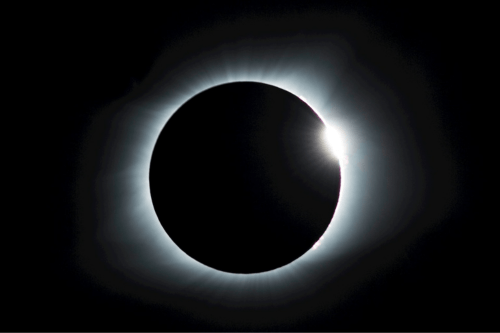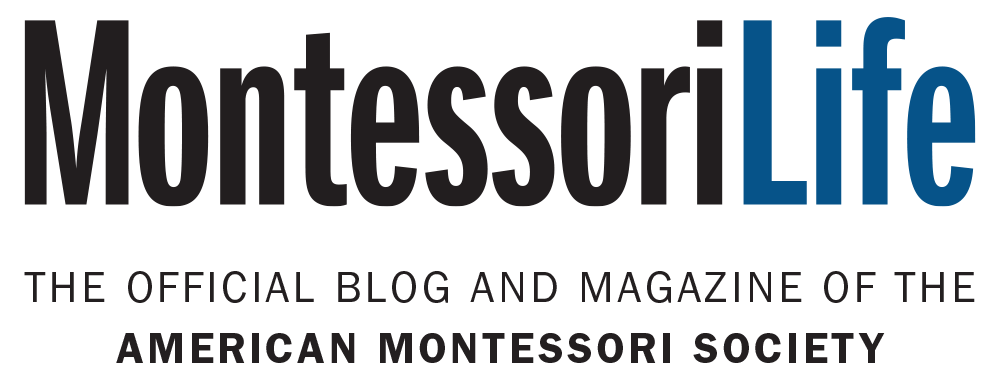Solar Eclipses and Montessori Classrooms

Each year, as Montessori children celebrate their birthdays by walking around the sun, they deepen their understanding of the solar system, the universe, and their place in it. On April 8 this year, Montessori students in a large portion of North America will have a similar opportunity as they witness and learn about a total solar eclipse, the last such event to be seen from the contiguous United States until 2044.
Weather permitting, people along the path of totality will be able to see the sun’s corona, or outer atmosphere, which is usually blocked by the sun’s bright rays. Observers viewing the eclipse from outside the path may observe a partial eclipse, where the moon covers most, but not all, of the sun. For those who are outside the totality path, NASA provides livestreaming of eclipse events that allow students and adult learners of all ages to experience this once-in-a-lifetime phenomenon. You can learn more about the solar eclipse and view an interactive map on the National Aeronautics and Space Administration (NASA) website.
Studying the Solar Eclipse in Montessori Classrooms at Different Levels
Throughout history, solar and lunar eclipses have provoked astonishment. From ancient civilizations to more recent societies, spiritual interpretations have abounded from around the world.
Montessori educators today understand that solar eclipses are exciting events that provide students and teachers unique opportunities to learn about astronomy and the beauty of the natural world. Check out the following resources and activities to help guide Montessori learners of all ages!
Early Childhood
- Make special eclipse glasses!
- Visit a local planetarium that may be offering shows about the eclipse.
- Simulate a solar eclipse using a flashlight and a globe.
- Create Solar Eclipse 3-part cards.
- Introduce a Phases of the Moon puzzle.
- Make a paper model using black construction paper and orange and yellow paint.
- Play a variation of “Duck, Duck, Goose” called “Sun, Sun, Moon” where the moon chases the sun. When the moon catches the sun, the kids say “Total Eclipse!”
- Read a book about eclipses such as Someone is Eating the Sun by Ruth A. Sonnenborn and illustrated by Eric Gurney or The Big Eclipse by Nancy Coffelt.
 Elementary
Elementary
- Watch a Solar Eclipse 101 video produced by National Geographic which provides descriptions of the different types of solar eclipses.
- Visit the varied resources on the Eclipse website including a Solar Eclipses for Beginners page.
- Watch this video explaining the three basic types of solar eclipses.
- Introduce this PBS lesson that allows students to experience a total solar eclipse and learn about the mechanics of eclipses.
- Provide students with the materials to make a paper or three-dimensional model of a solar eclipse.
- Allow students to express themselves creatively with a solar eclipse art project.
- Read a book about eclipses such as When the Sun Goes Dark by Andrew Fraknoi and Dennis Schatz, Totality!: An Eclipse Guide in Rhyme and Science by Jeffrey O. Bennett or What is a Solar Eclipse? By Dana Meachan Rau.
Secondary
- Read Solar Science: Exploring Sunspots, Seasons, Eclipses, and More by Dennis Schatz and Andrew Fraknoi.
- INFOhio has a World Book eclipse web quest appropriate for middle and high school students, providing them the opportunity to apply research and literacy skills to discover the mechanisms and safe viewing of eclipses.
- Explore ancient beliefs about eclipses through NASA’s stories from four cultures.
- Read the article, Three times scientists learned something from solar eclipses and three times they were tricked, which can serve as a good basis for discussing how scientific knowledge changes and the connection amongst various fields of science.
Adult Learners
- Share the National Science Teachers Association (NSTA)’s Solar Eclipse Guide for Educators and the Safe Solar Eclipse Viewing Techniques video.
- Watch NSTA’s archive video from veteran astronomers and educators Dennis Schatz and Andrew Fraknoi about the eclipse. This includes classroom-tested activity ideas.
- Share the NSTA’s guide on How to Safely Observe the Sun with Young Children.
For Students of All Levels: Connecting with the History of Solar Eclipses
Age-appropriate stories and lessons about the role of and beliefs related to solar eclipse can benefit students of various levels.
- Ancient Chinese stories explain that solar eclipses occurred when a celestial dragon attacked and devoured the sun. People would bang drums and make loud noises to frighten away the dragon.
- Ancient Hindu legend depicts a demon named Rahu who disguised himself as a woman while attending a banquet of the gods in an attempt to drink their nectar and gain immortality. Discovered by Vishnu, he was beheaded. It is said that it is his decapitated head flying across the sky that darkens the sun.
- The Inca believed solar eclipses were a sign of Inti, the all-powerful sun god. Following an eclipse, spiritual leaders attempted to appease Inti by fasting.
- Choctaw legend states that a mischievous black squirrel gnawing on the sun is the cause of eclipses. The squirrel is frightened away by human commotion.
- The Batammaliba, an ancient people from West Africa, believed that human anger and fighting spread to the sun and the moon, who began to fight with each other causing the eclipse. During an eclipse, Batammaliba people make amends and come together to encourage peace.
Your Students and the April 2024 Eclipse
We would love to hear how your school or teacher education program has incorporated the eclipse into your curriculum this school year. We welcome any pictures and brief descriptions of your activities to be potentially featured in a future Montessori Life blog or magazine article. Contact us at montessorispotlight@amshq.org and learn more about how to pitch other ideas for a Montessori Spotlight Story.
About the Author

|
Heather White, EdS, is a Montessori coach and consultant, content creator, and educator for adult learners, as well as a moderator and manager for the Montessori at Home (0 – 3 years) Facebook group. Formerly, she was a Montessori teacher, in-home caregiver, Lower Elementary coordinator, and associate head of school. She also has experience as a school psychologist intern. She is AMS-credentialed (Early Childhood, Elementary I) and is a Nationally Certified School Psychologist (NCSP). Contact her at hpratt@stetson.edu. |
Interested in writing a guest post for our blog? Let us know!
The opinions expressed in Montessori Life are those of the authors and do not necessarily represent the position of AMS.
















